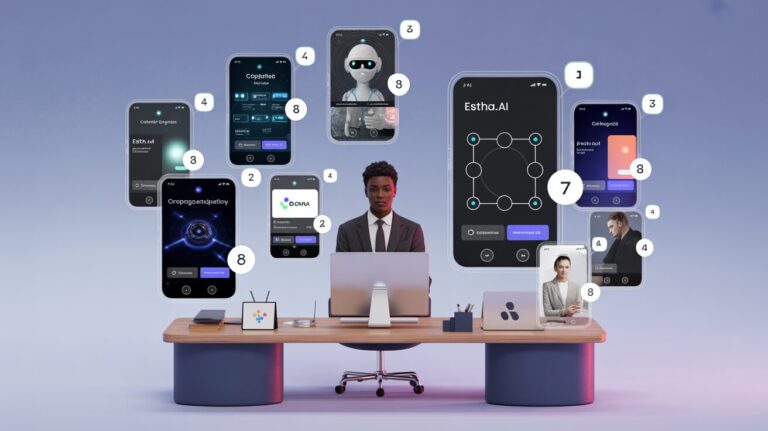Table Of Contents
- Understanding SaaS Churn: The Silent Revenue Killer
- What is a SaaS Renewal Predictor?
- How AI Transforms Renewal Prediction
- Key Metrics That Power Renewal Prediction
- Implementing Renewal Prediction in Your SaaS Business
- Overcoming Challenges in Renewal Prediction
- No-Code AI Solutions for Renewal Prediction
- The Future of Renewal Prediction Technology
For SaaS companies, customer churn isn’t just a metric—it’s an existential threat. Every lost customer represents not only immediate revenue decline but also the vanishing of future growth potential and increased customer acquisition costs. While the average SaaS churn rate hovers around 5-7% annually, top-performing companies maintain rates below 3% by taking a proactive, data-driven approach to customer retention.
Enter the SaaS renewal predictor—an AI-powered solution that transforms how businesses identify at-risk customers and take action before cancellation occurs. By leveraging customer data, usage patterns, and behavioral signals, these predictive systems provide an early warning system that can dramatically reduce churn and strengthen your bottom line.
In this comprehensive guide, we’ll explore how renewal prediction technology works, the metrics that matter most, implementation strategies that drive results, and how even non-technical teams can harness AI’s power through no-code platforms to create custom renewal prediction systems.
AI-Powered SaaS Renewal Prediction
Reduce Churn & Boost Customer Retention
The Problem
A 5% monthly churn compounds to 46% annual customer loss. For 1,000 customers paying $100/month, that’s $560,000 in lost annual revenue.
The Solution
AI-powered renewal prediction identifies at-risk customers before they cancel, enabling proactive retention strategies when intervention is most effective.
How AI Transforms Renewal Prediction
Complex Pattern Recognition
Identifies subtle patterns across thousands of customer data points human analysts might miss
Adaptive Learning
Continuously refines predictive models as customer behaviors and market conditions evolve
Personalized Assessment
Generates individualized risk scores tailored to each customer’s unique usage patterns
Targeted Interventions
Recommends specific retention actions based on similar customer journeys and historical success
Key Metrics That Power Renewal Prediction
Product Engagement
- Login frequency
- Feature adoption rate
- Time-in-app
- Core value metrics
Customer Success
- NPS/satisfaction scores
- Support ticket volume
- Time-to-value
- Expansion revenue
Account Health
- Champion changes
- Billing issues
- Contract utilization
- Business changes
Implementation Roadmap
Data Foundation
Unify customer data from multiple sources
Define Signals
Identify success and risk indicators
Model Development
Build prediction models with AI
Operationalize
Create alerts and intervention playbooks
Start Building Your Own Renewal Predictor
No-code AI platforms like Estha enable any SaaS business to build custom renewal prediction systems without technical expertise.
Understanding SaaS Churn: The Silent Revenue Killer
Churn—the percentage of customers who cancel or fail to renew their subscriptions within a given timeframe—is particularly devastating in the SaaS industry. Unlike traditional businesses where customer acquisition and one-time purchases drive growth, SaaS companies rely on the compounding value of long-term customer relationships.
The mathematics of churn are sobering: A seemingly modest monthly churn rate of 5% compounds to over 46% annual customer loss. For a company with 1,000 customers paying $100 monthly, that’s $560,000 in lost annual recurring revenue. Factor in customer acquisition costs (typically 5-7x higher than retention costs) and the downstream impact on company valuation (which often correlates directly with growth rate), and it becomes clear why churn reduction is mission-critical.
Yet many SaaS businesses still approach churn reactively—addressing issues only after customers have already decided to leave. This reactive approach is like trying to repair a boat after it’s begun sinking: technically possible, but exponentially more difficult and expensive than preventative maintenance.
What is a SaaS Renewal Predictor?
A SaaS renewal predictor is an analytical system that forecasts the likelihood of a customer renewing their subscription based on multiple data points. Unlike basic churn analysis that looks at historical patterns, renewal predictors use sophisticated algorithms to identify specific customers at risk of cancellation before they’ve made the decision to leave.
These systems work by establishing correlations between customer behaviors, engagement patterns, and renewal outcomes. For example, a renewal predictor might determine that users who log in less than once per week in the second month of subscription have a 78% higher probability of cancellation within 90 days. Armed with these insights, customer success teams can prioritize outreach to specific accounts when intervention will be most effective.
Modern renewal predictors typically provide three key outputs:
- A renewal probability score for each customer (often expressed as a percentage)
- The specific risk factors contributing to that score
- Recommended actions based on customer segment and risk profile
How AI Transforms Renewal Prediction
While basic renewal prediction is possible with statistical modeling, artificial intelligence elevates these capabilities to new heights. Traditional approaches rely on a limited set of predefined variables and struggle to adapt to changing business conditions. AI-powered systems, by contrast, can:
Identify complex patterns across thousands of variables. Machine learning algorithms can analyze granular interaction data—clicks, feature usage, support interactions, and more—to identify subtle patterns human analysts might miss. For example, AI might discover that customers who use a specific feature combination in their first two weeks are 3x more likely to renew, even if their overall usage time is lower.
Adapt to changing customer behaviors. As market conditions and customer expectations evolve, AI systems continuously refine their predictive models based on new data. This means prediction accuracy improves over time rather than degrading.
Provide individualized renewal risk assessments. Rather than applying broad segment-based rules, AI can generate renewal probabilities tailored to each customer’s unique usage pattern, making intervention efforts more targeted and efficient.
Recommend personalized retention strategies. Advanced AI systems don’t just identify at-risk customers—they suggest specific actions most likely to improve retention based on similar customer journeys and historical success patterns.
Key Metrics That Power Renewal Prediction
Effective renewal prediction relies on monitoring a diverse set of metrics that collectively provide insight into customer health. While specific indicators vary by business model, the most valuable signals typically include:
Product Engagement Metrics
These metrics reflect how actively customers use your solution and derive value from it. Key indicators include:
Login frequency: How often users access your platform (daily, weekly, monthly)
Feature adoption rate: Percentage of available features customers actively use
Time-in-app: Duration of typical user sessions
Core value metrics: Indicators that users are achieving their desired outcomes (e.g., documents created, transactions processed)
Customer Success Indicators
These metrics capture the health of the customer relationship beyond product usage:
NPS or satisfaction scores: Direct feedback on customer sentiment
Support ticket volume/severity: Frequent or serious support issues often precede cancellation
Time-to-value: How quickly customers achieve their first success milestone
Expansion revenue: Customers purchasing additional seats or features (typically a positive retention indicator)
Account Health Signals
These metrics reflect business realities that may impact renewal decisions:
Champion changes: Turnover of key stakeholders who advocated for your solution
Billing issues: Payment failures or billing disputes
Contract utilization: Whether customers are using what they’ve paid for (e.g., API call volume relative to purchased limits)
The most sophisticated renewal predictors don’t view these metrics in isolation but consider how they interact. For instance, decreased usage might be more concerning when combined with recent support tickets than when it occurs during a known seasonal slowdown period.
Implementing Renewal Prediction in Your SaaS Business
Implementing an effective renewal prediction system requires a methodical approach that moves through several phases:
Phase 1: Data Foundation
Begin by unifying customer data from disparate sources. This typically includes:
Product analytics: User behavior and feature usage data
CRM data: Account information, communications history, and sales notes
Support systems: Ticket history and resolution metrics
Billing systems: Payment history and plan details
The key challenge in this phase is establishing a single customer view that combines these data streams. Modern customer data platforms (CDPs) can facilitate this integration, but even a basic data warehouse solution can provide sufficient foundation for initial prediction efforts.
Phase 2: Defining Success and Risk Signals
Before building predictive models, identify the specific signals that correlate with renewal and cancellation in your business:
Analyze historical churn: Examine the behavior patterns of customers who cancelled versus those who renewed
Identify leading indicators: Determine which metrics show meaningful changes before cancellation occurs
Create customer health scoring: Develop a preliminary scoring system based on these indicators
Phase 3: Model Development
Develop predictive models using your historical data. Options include:
Rules-based systems: For businesses with limited data, start with simple thresholds based on key metrics
Statistical models: Regression analysis to identify correlations between behaviors and outcomes
Machine learning models: For businesses with sufficient historical data, supervised learning algorithms can develop sophisticated prediction capabilities
No-code AI platforms: Solutions like Estha allow businesses to build custom AI applications without technical expertise
Phase 4: Operationalizing Insights
The most sophisticated prediction model adds no value unless it drives action. Effective operationalization includes:
Alert systems: Notify customer success teams when accounts reach risk thresholds
Intervention playbooks: Develop specific response strategies for different risk scenarios
Automation: Where appropriate, trigger automated interventions for early-stage risk signals
Measurement: Track the effectiveness of interventions to continuously refine strategies
Overcoming Challenges in Renewal Prediction
While the benefits of renewal prediction are clear, implementation comes with several challenges:
Data Quality and Integration Issues
Prediction models are only as good as their input data. Common challenges include:
Data silos: Customer information fragmented across systems
Incomplete data: Missing information for key behavioral indicators
Historical limitations: Insufficient historical data to identify reliable patterns
To overcome these challenges, start with the data you have while implementing better collection processes. Even limited prediction capabilities provide value while you build toward more sophisticated systems.
Balancing Prediction with Action
Many organizations struggle to translate predictive insights into effective interventions. Common pitfalls include:
Alert fatigue: Too many risk notifications leading to inaction
Unclear ownership: Confusion about which team is responsible for addressing specific risk factors
Intervention timing: Acting too early (creating unnecessary concern) or too late (when customer has already decided to leave)
The solution is developing clear playbooks that define responsibilities, intervention thresholds, and specific actions for different risk scenarios.
No-Code AI Solutions for Renewal Prediction
Traditionally, implementing sophisticated renewal prediction required data science expertise and custom development. This created a significant barrier for small and mid-sized SaaS companies without dedicated data teams. No-code AI platforms like Estha are changing this landscape by making advanced prediction capabilities accessible to customer success and product teams without technical backgrounds.
These platforms allow businesses to:
Build custom prediction models through intuitive interfaces that require no coding knowledge
Connect to existing data sources through pre-built integrations with CRM, product analytics, and support systems
Develop custom risk scoring tailored to specific business models and customer segments
Create automated workflows that trigger interventions based on risk scores
Continuously improve models based on intervention outcomes and new data
For example, a customer success manager could use Estha’s no-code platform to build a renewal prediction application that analyzes product usage data from their analytics platform, combines it with support ticket information, and generates custom risk scores for each account. The system could then automatically trigger different intervention pathways based on the risk level, from educational content for low-risk accounts to direct outreach for high-risk situations.
This democratization of AI capabilities means that even small SaaS teams can implement sophisticated prediction systems in days rather than months, without requiring specialized technical resources.
The Future of Renewal Prediction Technology
Renewal prediction technology continues to evolve rapidly, with several emerging trends poised to further enhance its effectiveness:
Sentiment analysis: Advanced natural language processing can analyze customer communications (support tickets, emails, survey responses) to identify emotional signals that precede churn
Real-time intervention: Instead of daily or weekly risk assessments, systems are moving toward continuous evaluation and immediate intervention when risk signals emerge
Prescriptive recommendations: Beyond identifying risk, next-generation systems will recommend specific features or content most likely to re-engage each at-risk user based on their unique profile
Holistic customer lifecycle management: Renewal prediction is increasingly integrated into broader customer success platforms that manage the entire customer journey from onboarding through expansion
As these technologies mature, the line between prediction and prevention will blur. The most advanced systems won’t simply forecast churn but will proactively reshape the customer experience to maximize retention before risk factors emerge.
Transforming Your Retention Strategy With Renewal Prediction
Implementing a SaaS renewal predictor represents one of the highest-ROI investments available to subscription businesses. By shifting from reactive to proactive retention management, companies can dramatically reduce churn rates, increase customer lifetime value, and create more predictable revenue growth.
The most successful implementations share several common elements:
Leadership commitment: Treating retention as a company-wide priority rather than just a customer success function
Data integration: Bringing together product, customer, and business data to create a holistic view of customer health
Action orientation: Focusing on translating predictions into specific interventions that improve outcomes
Continuous improvement: Regularly refining models based on intervention results and changing customer behaviors
While sophisticated AI capabilities were once available only to enterprises with dedicated data science teams, no-code AI platforms now make these tools accessible to businesses of all sizes. With solutions like Estha, even small SaaS companies can implement powerful prediction systems that identify at-risk customers, recommend targeted interventions, and meaningfully reduce churn.
In an increasingly competitive SaaS landscape where customer acquisition costs continue to rise, companies that excel at retention will enjoy significant advantages in unit economics, capital efficiency, and sustainable growth. Renewal prediction is no longer a nice-to-have capability—it’s an essential component of SaaS business strategy.



